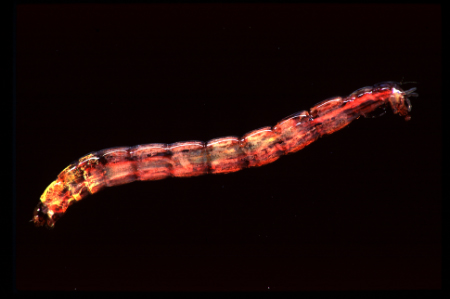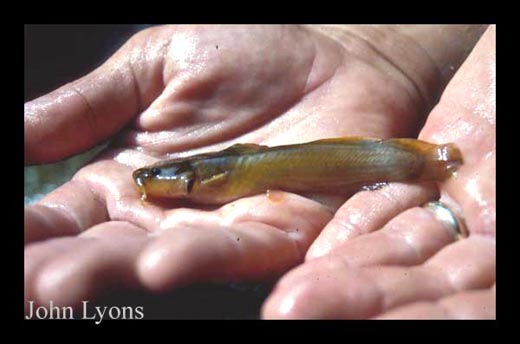Nutrition and Diet
Notorus exilis is a freshwater fish found in much of the central United States. As with any other fish the slender madtom has specific nutritional needs that must be met and a particular diet it uses to meet those needs. Unfortunately, information regarding the diet and nutrition of the slender madtom is somewhat varied and doesn't always match up perfectly. In looking through several different sources however, clear trends begin to appear.
First of all, it does the majority of its eating at certain times of day. The slender madtom generally stays very withdrawn and elusive during the daytime (Wisconsin Department of Natural Resources, 2013). Therefore, it will primarily eat as the sun sets in the evening and just before it rises in the morning. It rarely deviates from this schedule, eating only a tiny amount during the daytime hours (Vives, 1987).
 So,
just what is it that the slender madtom eats? Well, its physical size is a
major factor in deciding its diet. It only grows to between 3 and 5 inches in
length and it is rather small in diameter
(Minnesota Department of Natural Resources, 2013). As a result, the majority of
its diet consists of aquatic insect larvae rather than other fish. Furthermore,
according to Phillips and Kilambi (1996), the slender madtom consumes the larvae
of two particular families of flies more than any of the others. They are the Baetidae and
Chironomidae. While they stated that the Chironomids are the more heavily favored
food option, they also observed the slender madtom's preference between the two
types changes with the
seasons. In the winter and spring it consumes far more Chironomidae than
anything else, but then shifts towards eating more Baetidae in the summer and
fall. Yet, the slender madtom's diet is not at all restricted to these two
families. In fact, it will consume many different types of insect larvae as it
encounters them.
So,
just what is it that the slender madtom eats? Well, its physical size is a
major factor in deciding its diet. It only grows to between 3 and 5 inches in
length and it is rather small in diameter
(Minnesota Department of Natural Resources, 2013). As a result, the majority of
its diet consists of aquatic insect larvae rather than other fish. Furthermore,
according to Phillips and Kilambi (1996), the slender madtom consumes the larvae
of two particular families of flies more than any of the others. They are the Baetidae and
Chironomidae. While they stated that the Chironomids are the more heavily favored
food option, they also observed the slender madtom's preference between the two
types changes with the
seasons. In the winter and spring it consumes far more Chironomidae than
anything else, but then shifts towards eating more Baetidae in the summer and
fall. Yet, the slender madtom's diet is not at all restricted to these two
families. In fact, it will consume many different types of insect larvae as it
encounters them.
 While the diet of this fish does consist largely of fly larvae the
slender madtom is not one
dimensional in what it eats. Organisms such as crayfish, terrestrial insects, and
certain types of worms have all been found in the stomachs of slender madtoms (Phillips
and Kilambi, 1996). This variety suggests that they are at least partially
flexible in their diet and are open to many food
options when they are available.
While the diet of this fish does consist largely of fly larvae the
slender madtom is not one
dimensional in what it eats. Organisms such as crayfish, terrestrial insects, and
certain types of worms have all been found in the stomachs of slender madtoms (Phillips
and Kilambi, 1996). This variety suggests that they are at least partially
flexible in their diet and are open to many food
options when they are available.
In the search for food the slender madtom may use their barbels. Barbels are thin tentacle-like projections found around the mouth. They have the ability to taste and can be used to search through dark or dirty water for food (Encyclopedia of Life, 2013). Once the slender madtom has eaten, the nutrients must be absorbed and distributed throughout the body. To do this it must make use its digestive and circulatory systems. The slender madtom shares the same general anatomy as most fish when it comes to these parts of its anatomy. It possess a full digestive tract to absorb nutrients with. It distributes these nutrients all around the body using a closed circulatory system that includes a two chambered heart, a common feature in fish (Florida Fish and Wildlife Conservation Commission).
Now that you understand the nutrition and diet of the slender madtom, it's time to learn about their reproduction, or you can head back to the homepage.